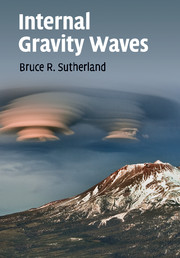3 - Internal waves in uniformly stratified fluid
Published online by Cambridge University Press: 05 October 2014
Summary
Introduction
If a fluid's potential density decreases continuously with height then it can support internal waves that, like interfacial waves, move up and down due to buoyancy forces but which are not confined to an interface: they can move vertically through the fluid. This chapter focuses upon the dynamics of small-amplitude internal waves in uniformly stratified, stationary fluid. It also examines some effects of shear in non-uniform stratification, with a more general treatment given in Chapter 6.
The key quantity that determines the temporal evolution and spatial structure of internal waves is the buoyancy frequency. Heuristic methods based on fluid-parcel arguments are used to define the buoyancy frequency. These help to anticipate the dispersion relation that describes internal waves that are not influenced by rotation. The dispersion relation for Boussinesq and non-Boussinesq waves is then derived for liquids and gases. The results are then extended by including the influence of boundaries, shear and rotation.
The buoyancy frequency
In our consideration of interfacial waves we assumed that the density changed discontinuously across the interface between, say, warm and cold or fresh and salty fluid. In reality, such interfaces are not infinitesimally thin. They are thick, and the density varies continuously from one side of the interface to the other. We can justifiably assume the interface thickness is negligibly small only if the horizontal scale of interfacial disturbances is relatively large. If this is not the case, then the effects of continuous vertical density variations must be considered.
- Type
- Chapter
- Information
- Internal Gravity Waves , pp. 141 - 212Publisher: Cambridge University PressPrint publication year: 2010



